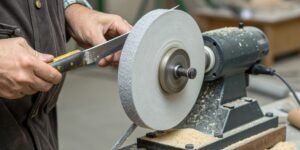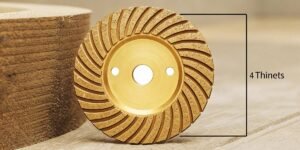
Dull chisels tear wood, ruin projects, and waste your time. Learning to sharpen them by hand restores their precision, making your work effortless and enjoyable again.
To hand-sharpen a wood chisel, you need a sharpening stone and a steady hand or guide. First, flatten the back of the chisel on a coarse stone. Then, sharpen the beveled edge at a 25-30 degree angle until a burr forms. Finally, remove the burr and polish the edge for a razor-sharp finish.

In my nearly three decades at our grinding tool factory here in Henan, I’ve seen countless tools come and go. The one thing that never changes is the deep satisfaction of using a perfectly sharp edge. It connects you to your work in a fundamental way. A dull tool fights you, but a sharp one becomes an extension of your own hands. This is especially true for wood chisels1. Many people think hand sharpening is a difficult art, but it’s really a science. It’s about consistency, the right tools, and a bit of patience. Let’s break down the process so you can get that perfect edge every single time. It’s easier than you think, and the results speak for themselves.
What is the best method for sharpening wood chisels with a whetstone?
Whetstones can seem messy and difficult to use correctly. You might try and fail, leading to uneven edges, frustration, and a chisel that’s worse than when you started.
The best method is a multi-stage process. Use a coarse whetstone to establish the angle and fix any nicks. Then, move to a finer stone to hone the edge. Always keep the stone lubricated and maintain a consistent angle for a professional, razor-sharp result.

At our factory, we produce thousands of grinding wheels daily, and it all comes down to a simple principle: start coarse, finish fine. The same logic applies perfectly to using a whetstone for your chisels. I tell our clients that getting a great edge isn’t about one magic step; it’s about a consistent process.
Step 1: Flattening the Back
Before you even think about the bevel, you must ensure the back of the chisel is perfectly flat. A curved back makes a truly sharp edge impossible. I always start by placing the back of the chisel flat on my coarsest stone and rubbing it back and forth until the entire last inch is shiny and uniform. This creates the foundation for a sharp edge.
Step 2: Grinding the Primary Bevel
Next, you shape the main bevel. I personally recommend a honing guide2 for this, as it guarantees a consistent angle. Set your guide to about 25 degrees. Using your medium-grit stone (around 1000-2000 grit), push the chisel back and forth across the lubricated stone. Keep going until you can feel a small burr, or a wire edge, form along the entire length of the cutting edge.
Step 3: Honing and Polishing
Once the burr is formed, it’s time to refine the edge. Switch to your finest stone (4000-grit or higher). With just a few light strokes on the bevel, you will polish the edge to a mirror finish. Then, lay the chisel flat on its back again and make one or two light passes to cleanly slice off the burr. This final step is what creates that incredible sharpness.
| Stone Grit | Purpose | Recommended For |
|---|---|---|
| Coarse (<1000) | Repairing chips, establishing a new bevel | Damaged or very dull chisels |
| Medium (1000-3000) | General sharpening, creating a burr | Regular maintenance sharpening |
| Fine (4000+) | Honing and polishing the final edge | Creating a razor-sharp finish |
What equipment is necessary for sharpening chisels by hand?
You want to start sharpening, but you are not sure what to buy. Pouring money into the wrong tools is a frustrating waste that won’t give you the results you need.
At minimum, you need a combination whetstone, like a 1000/6000 grit model, or a set of diamond plates. A honing guide is highly recommended for beginners to ensure a consistent angle. Lubricant (water or oil) and a leather strop for final polishing complete your essential kit.

Over the years, our customers have asked me this question countless times. They see a huge variety of products and don’t know where to start. My advice is always to keep it simple but focus on quality. You don’t need a dozen different stones, just a few good ones that do their job well.
Sharpening Stones
This is the heart of your setup. You have two main choices: waterstones (whetstones) or diamond stones. Waterstones give excellent feedback and produce a very fine edge, but they wear down over time and need to be flattened. Diamond stones, like some of the superhard abrasive products we manufacture, stay perfectly flat and cut very fast, but they can feel more aggressive. For a beginner, a combination waterstone is a great, affordable start.
Honing Guides
Can you sharpen without one? Yes. Should you? As a beginner, probably not. A honing guide is a simple jig that clamps your chisel and holds it at a perfect, unwavering angle to the stone. It removes all the guesswork and is the single best tool for learning the proper feel of sharpening. Even many experts I know still use them for consistency.
Lubrication and Polishing
Your stones need lubrication to clear away metal filings (called swarf) and prevent overheating. For waterstones, use water. For oilstones, use a light mineral oil. Finally, a leather strop3 charged with a bit of polishing compound is the secret to taking your edge from just "sharp" to "scary sharp." A few pulls on the strop after sharpening realigns and polishes the very tip of the blade.
| Tool Type | Pros | Cons |
|---|---|---|
| Waterstones | Great feedback, produce a fine polish, affordable. | Wear down over time, require flattening. |
| Diamond Stones | Stay flat forever, cut very fast, long-lasting. | Can be more expensive, less "feel" than waterstones. |
How do you create a microbevel when hand-sharpening a chisel?
You spend time getting your chisel sharp, but it seems to dull too quickly. Constantly re-sharpening the entire bevel is time-consuming and wears away your valuable tools faster.
To create a microbevel, first sharpen the main bevel at its primary angle, like 25 degrees. Then, slightly increase the angle by just one or two degrees and make a few final passes on your finest stone. This creates a tiny, stronger bevel right at the cutting edge.

The microbevel4 is a brilliant technique that I recommend to all our professional clients. I remember a customer in Germany who worked with tough, hard oak. His chisel edges were constantly chipping. The primary bevel was sharp, but too fragile for the material. We advised him to add a microbevel4, and it completely solved the problem. It’s a small change that makes a huge difference in both edge durability and the speed of future sharpening.
Why Use a Microbevel?
A standard 25-degree bevel is excellent for slicing through wood fibers, but the edge is very thin and can be fragile. The microbevel4, being a slightly steeper angle (27-30 degrees), adds more steel directly behind the cutting edge. This makes it much more durable and resistant to chipping, especially in hardwoods. More importantly, when the chisel gets dull, you only need to re-sharpen this tiny microbevel, not the entire face of the primary bevel. This takes just a few seconds and removes very little metal, extending the life of your chisel.
The Technique in Detail
Start with a fully sharpened chisel, honed to its primary bevel (e.g., 25 degrees). If you are using a honing guide, simply adjust the blade so it extends a tiny bit less, which will slightly increase the angle. If you are sharpening freehand, just raise the back of the chisel by a hair. Then, on your finest whetstone or diamond plate, make about five to ten light strokes. You are only polishing a sliver of metal at the very tip. You should be able to see a new, very thin line of light reflecting right at the edge. That’s your microbevel.
| Wood Type | Main Bevel Angle | Microbevel Angle | Purpose |
|---|---|---|---|
| Softwoods (Pine, Fir) | ~25° | ~27° | Easier slicing, less edge retention needed. |
| Hardwoods (Oak, Maple) | ~30° | ~32° | More durability for tougher material. |
What are the most common mistakes to avoid when sharpening chisels by hand?
You followed the steps, but your chisels still don’t feel right. You might be making common mistakes that are undermining all of your hard work and preventing a truly sharp edge.
The most common mistakes are an inconsistent sharpening angle, which rounds the edge; not flattening the chisel’s back; pressing too hard on fine stones; and failing to remove the burr completely. Also, letting the stone get dry can overheat and ruin the steel’s temper.

In our factory’s quality control department, consistency is everything. A process is only reliable if it’s repeatable. The same principle applies to sharpening. A small, seemingly innocent mistake, when repeated, can ruin an otherwise perfect process. I’ve seen beautifully made chisels damaged by poor sharpening technique. Avoiding these common pitfalls is just as important as learning the correct steps.
The Rocking Motion
This is the number one error for freehand sharpeners. If you can’t keep your wrists and arms locked at a stable angle, the chisel will rock back and forth. This action rounds over the cutting edge instead of creating a flat, sharp bevel. The solution is simple: use a honing guide until your muscle memory is perfect.
Neglecting the Back
Many people focus all their energy on the bevel and completely ignore the back of the chisel. A sharp edge is formed where two perfectly flat planes meet. If the back is curved or rough, you will never get a truly sharp edge, no matter how much time you spend on the bevel. Always start by flattening the back.
Skipping Grits and Pressing Too Hard
Good sharpening is a process of refinement. Each grit size5 is designed to remove the scratches from the previous, coarser grit. If you jump from a 400-grit stone straight to a 6000-grit stone, the fine stone has to work too hard and will never fully polish the edge. Likewise, pressing too hard, especially on fine stones, can gouge the stone and create a large, weak wire edge instead of a clean burr. Let the abrasive do the work.
| Common Mistake | Why It’s a Problem | The Correct Way |
|---|---|---|
| Inconsistent Angle | Rounds the cutting edge, making it dull. | Use a honing guide or practice locking your wrists. |
| Not Flattening the Back | A curved back prevents a truly flat, sharp edge. | Always start by lapping the back on a flat stone. |
| Pressing Too Hard | Can damage fine stones and create a weak wire edge. | Use light pressure, especially on your finer stones. |
Conclusion
Mastering hand-sharpening takes practice. But with the right tools and techniques, you can get a perfect edge that makes your woodworking projects a true pleasure. Happy sharpening!
-
Find recommendations for beginner-friendly wood chisels that will make your sharpening journey easier. ↩
-
Learn about honing guides and how they can improve your sharpening consistency and results. ↩
-
Learn the technique of using a leather strop to achieve a polished edge on your chisels. ↩
-
Understand the concept of a microbevel and how it can extend the life of your chisels. ↩ ↩ ↩
-
Understand how different grit sizes affect the sharpening process and the quality of the edge. ↩
Written by
leeon
You may also be interested in:

How to use a hard felt bench grinding wheel on knives?
Getting a razor-sharp, polished edge on a knife can be frustrating and slow. A dull knife is dangerous, and using the wrong tool can easily

What are grinding cracks and how do you stop them?
Are tiny cracks appearing on your ground surfaces? This problem leads to part failure, wasting time and money. You can solve it by understanding the

What does an angle grinder do that other tools can't?
Struggling with tools for multiple tasks? Carrying a heavy toolbox is inefficient. An angle grinder replaces many tools, saving you time and effort on the

How to reduce the cycle time in a grinding machine?
Is your grinding process a major bottleneck? Slow cycle times hurt your bottom line and delay deliveries. You can speed up production by optimizing key

Do you regularly sharpen your chisels? If so, how?
A dull chisel ruins wood and causes frustration. This wastes time and expensive materials. Learning to sharpen correctly is the simple, game-changing solution you need

How is a grinding wheel specified?
Confused by the codes on a grinding wheel? Making the wrong choice costs money and ruins parts. Let me show you how to read them
